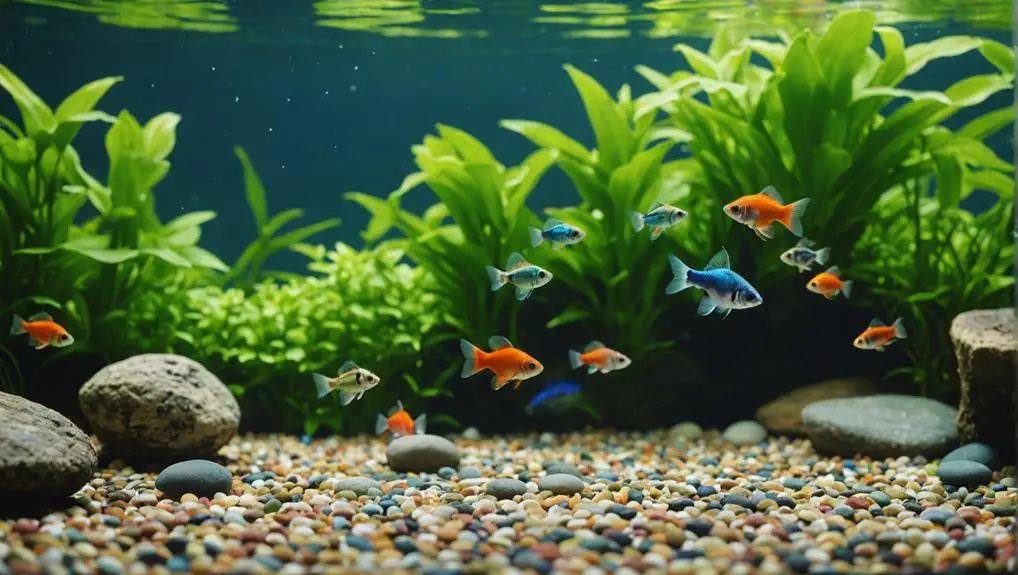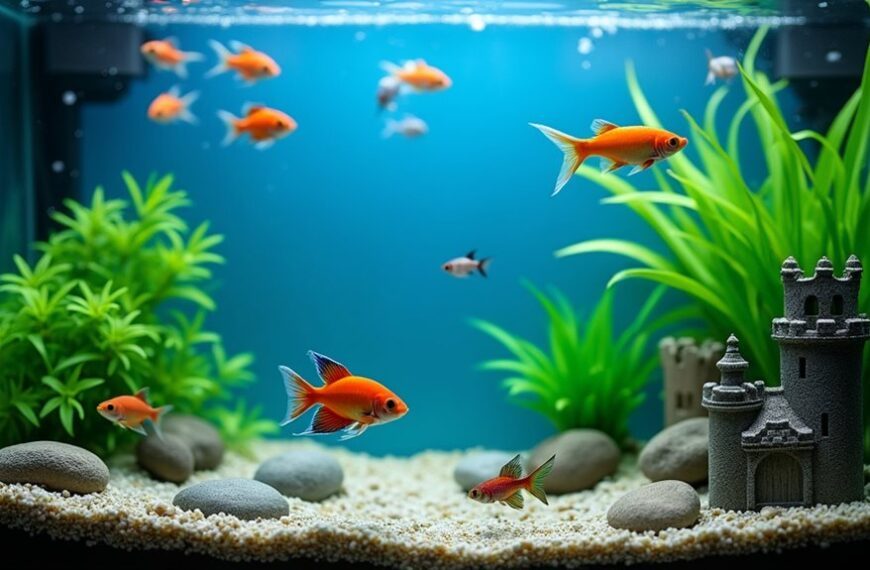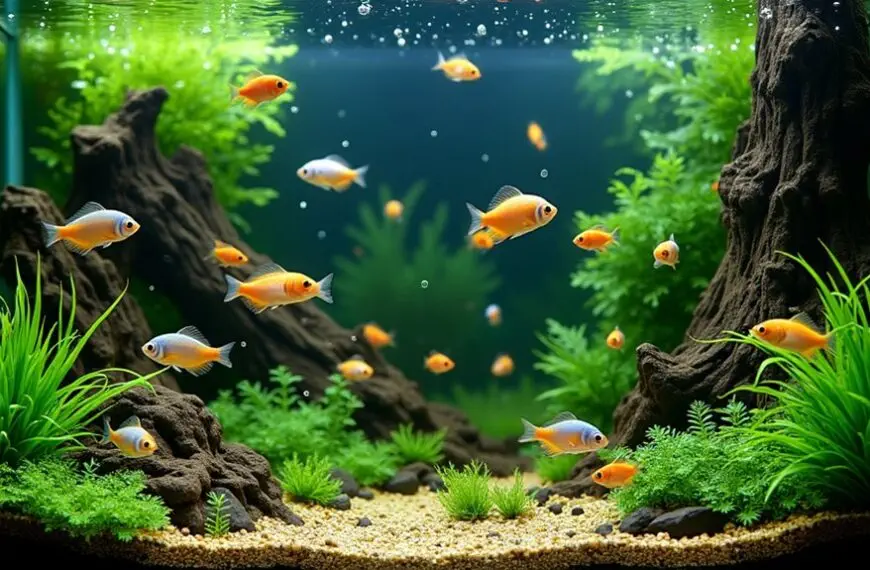If you're starting out in fishkeeping, you've got some delightful options! Consider adding Rasboras or Tetras for their vibrant colors and friendly nature. Common Goldfish can be fun, but remember they need space. Corydoras are peaceful little scavengers that love to hang out in groups. Platies are lively and easy to care for, while Betta Fish are striking but prefer to be solo. If you want a calm community fish, look at Bolivian Cichlids. Each species brings unique joy to your aquarium. Stick around, and you'll discover even more awesome fish to consider!
Contents
Rasboras
Rasboras are a fantastic choice for beginner aquarists looking to add vibrant colors and lively behavior to their community tanks. These small schooling fish, like the popular harlequin rasbora, not only brighten up your aquarium but also bring a sense of harmony. Their peaceful demeanor makes them ideal for community tanks, as they get along well with other gentle fish, such as tetras and corydoras.
Additionally, rasboras thrive in optimal tank conditions, such as a well-planted environment and stable water parameters, which contribute to their overall health and happiness optimal tank conditions.
You'll find that rasboras are easy to care for, making them perfect for novice aquarists. They thrive in groups of six or more, which helps reduce stress and creates a dynamic display of active behavior. Watching them swim together is like seeing a beautiful little dance unfold right in your living room!
Besides the harlequin rasbora, you might also consider the lambchop rasbora or the neon green rasbora. All of these species enhance your aquarium's charm and color.
Common Goldfish
Common goldfish are a popular choice for beginner aquarists, and for good reason!
They're hardy and can grow quite large, so you'll need to provide them with a spacious tank—at least 30 gallons per fish—to keep them happy.
Additionally, goldfish can live for 10-20 years, making them a long-term commitment for families.
Plus, their feeding preferences are pretty straightforward, but remember to control those portions; nobody wants a goldfish with a bellyache!
knowledge of water quality management is crucial for maintaining healthy goldfish.
Care Requirements
When caring for common goldfish (Carassius auratus), it's essential to provide them with a spacious environment; a minimum tank size of 30 gallons per fish is necessary to ensure they thrive. These active swimmers can grow up to 12-14 inches, so giving them plenty of room is key to their happiness.
Goldfish are among the best beginner fish because they're easy to keep and can tolerate a range of water parameters. However, keeping an eye on water quality is crucial. Frequent water changes help manage waste and keep their environment clean.
Remember, these docile fish can produce a high bioload, so adequate filtration and aeration are must-haves!
While they can be a bit nippy with tank mates, it's generally best to stick to single-species setups to avoid stress. They're not exactly small fish, but they'd love to have their own space to swim around.
If you want to create a community tank, just be mindful of their temperament. With a bit of care and attention, your goldfish will flourish and bring joy to your aquatic world!
Feeding Preferences
Feeding goldfish requires attention to their dietary needs to keep them healthy and vibrant. These little swimmers prefer a diet low in protein, so you'll want to focus on goldfish pellets that are specially formulated for them.
Don't forget to mix things up! Regularly varying their diet with treats like spirulina algae, blanched peas, and soft vegetables like romaine lettuce can help maintain a balanced diet and keep them engaged.
Overfeeding is a big no-no! Goldfish are large waste producers, and too much food can quickly degrade water quality, which isn't good for them or your tank.
Aim for a proper diet routine by feeding them once or twice a day. This helps prevent boredom and ensures they get all the necessary nutrients for optimal health.
Tetras
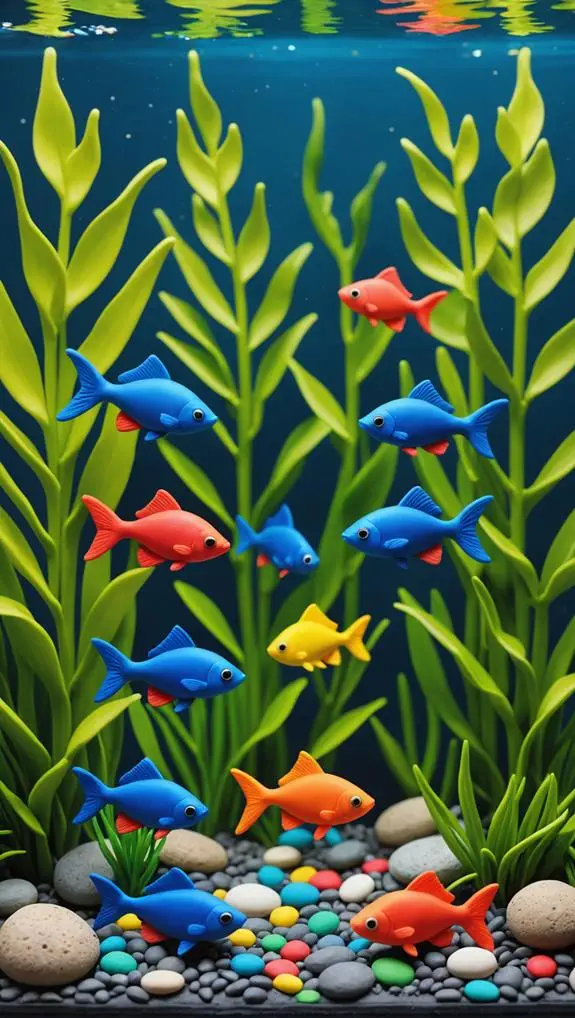
When you think of colorful fish, tetras probably pop into your mind right away. These little guys, especially neon and cardinal tetras, aren't just pretty faces; they thrive in groups and bring a lively energy to your tank.
They prefer living in schools, so it's best to keep a minimum of six to ensure their happiness and reduce stress. With the right water conditions and a balanced diet, they'll show off their stunning colors and make your aquarium feel like a vibrant underwater party!
Popular Tetra Varieties
Tetras are among the most popular choices for beginner aquarists due to their vibrant colors and peaceful nature.
These delightful freshwater fish come in various varieties, each offering unique charms.
Here's a quick look at some popular tetra species you might consider for your community aquarium:
- Neon tetras: Known for their stunning blue and red coloration, they grow up to 1.5 inches and thrive in schools of at least six.
- Cardinal tetras: Similar to neon tetras but slightly larger at 2 inches, they prefer slightly more acidic water.
- Serpae tetras: With their vibrant red and black colors, they also grow to about 2 inches and should be kept in groups of six or more to keep aggression in check.
- Black phantom tetras: These calm fish can reach 2.5 inches and prefer well-planted tanks for hiding.
- Small size: All these tetras are easy to care for and adapt well to different water parameters, making them perfect for beginners.
Ideal Tank Conditions
Creating the right environment for your tetras is key to their health and happiness. To keep these colorful fish thriving, aim for ideal tank conditions. Start with stable pH levels between 6.0 and 7.8, depending on the species you choose.
Most tetras prefer a cozy water temperature between 74°F and 78°F. This warmth encourages them to swim around and show off their vibrant colors.
You'll want to maintain well-maintained tanks with adequate filtration. Tetras can be sensitive to poor water quality, so regular water changes every 2-4 weeks are a must.
Consider setting up heavily planted tanks, as they provide plenty of hiding spots where your tetras can feel secure. Trust me, they'll appreciate having a place to retreat!
Lastly, remember that tetras are social creatures. Keeping them in schools of at least six fish will help reduce stress and promote their natural behaviors. Plus, watching them swim together is a joy!
With these tips in mind, you're well on your way to creating a beautiful and thriving home for your tetras. Happy fishkeeping!
Corydoras
Adding Corydoras catfish to your aquarium can enhance both its beauty and dynamics. These peaceful bottom dwellers are perfect for community tanks, especially when kept in groups of at least three to six. With over 160 species, like the charming bronze and panda corys, their unique patterns and colors can be a delightful addition to your setup.
Here's what you should know about Corydoras:
- They're scavengers, keeping your substrate clean while searching for food.
- Their diet should consist of sinking pellets and wafers to meet their nutritional needs.
- A soft substrate is essential to protect their sensitive barbels from injury.
- Corydoras thrive in stable water conditions and are quite active.
- Their social nature makes them engaging companions for other peaceful fish.
Platies
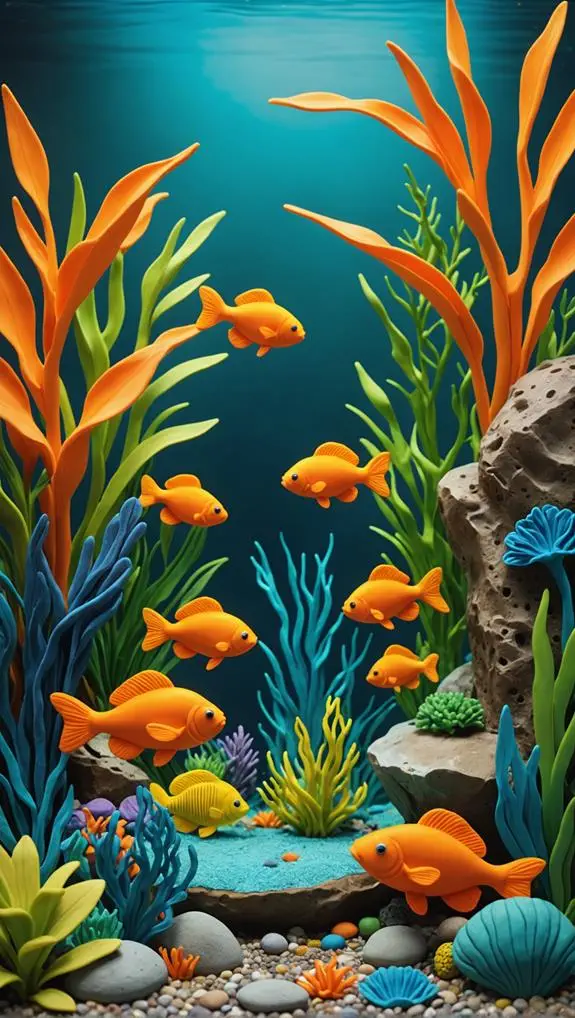
Platies are vibrant and lively fish that can bring a splash of color to your aquarium. As a beginner aquarist, you'll love how easy they're to care for. These little beauties typically grow to about 3 inches and thrive in various water conditions, making them perfect for newcomers.
To keep them happy, aim for a tank size of at least 10 gallons, where they can swim in schools of 3-5 individuals.
Platies are livebearers, meaning the females give birth to free-swimming young. This can add a delightful surprise to your tank if you decide to breed them!
Plus, their omnivorous diet is a breeze to manage. They enjoy a mix of flakes, pellets, and even vegetation, so feeding them is simple and flexible.
One of the best parts? Platies come in an array of color morphs, from solid hues to intricate patterns. This variety lets you create a stunning community tank that'll impress your guests.
Betta Fish
If you're looking to add even more personality to your aquarium, consider betta fish. These stunning aquatic pets are known for their vibrant colors and elaborate fins, making them a favorite among beginner aquarists. Just remember, they come with some unique needs!
- Minimum tank size: 5 gallons
- Ideal water temperature: 78 to 82°F
- Territorial behavior: Males must be solo
- Balanced nutrition: High-quality pellets are key
- Plants and hiding spots: Essential for a happy betta
Betta fish thrive when they've a comfortable environment. They're quite territorial, especially the males, so it's best to keep them alone.
If you opt for females, they can live together in groups of five to six, creating a lovely sorority. Make sure to maintain the right water temperature and provide balanced nutrition with high-quality pellets. Overfeeding can lead to health issues, so be mindful of their small stomachs!
Lastly, adding plants and hiding spots will create a stress-free habitat. Your betta will appreciate the opportunity to explore and feel secure. With the proper care, your betta fish will bring joy and color to your home!
Barbs
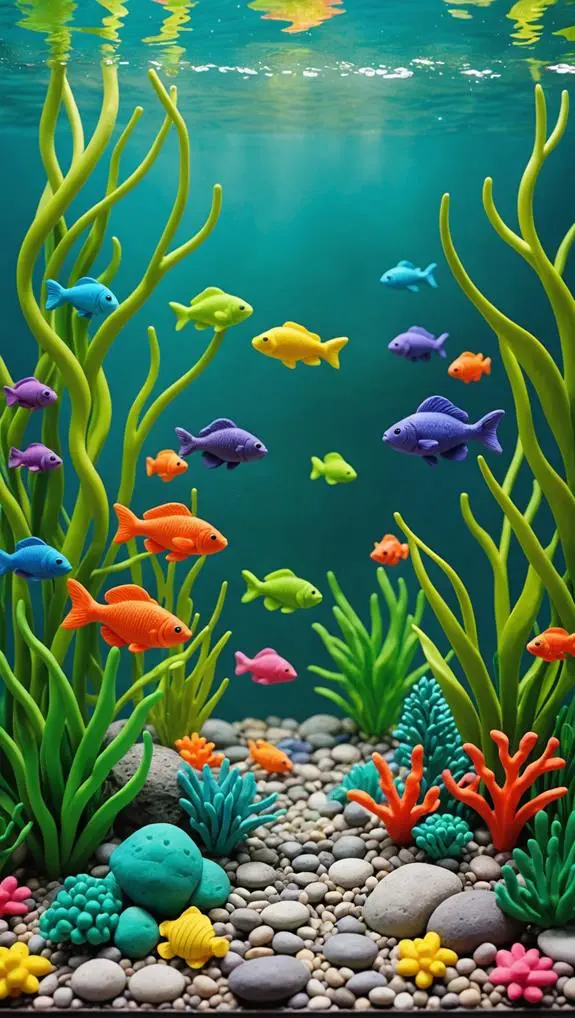
Barbs are a lively and entertaining choice for beginner aquarists looking to enhance their freshwater aquarium. These active fish, like the tiger and cherry barbs, typically grow to about 3 to 4 inches and bring a splash of energy to your tank. They thrive in groups of at least six, which helps keep their semi-aggressive behavior in check. Trust me, no one likes a fish fight!
When it comes to tank conditions, barbs prefer well-maintained environments, so regular water changes are essential. They do best alongside other community fish like rasboras and tetras, but be cautious with long-finned species. Those little nippers can be a handful!
Feeding your barbs a varied diet is crucial for their health and vibrant colors. High-quality flake food, pellets, and occasional live or frozen treats will keep them happy and thriving.
Just imagine the joy they'll bring as they dart around your tank, showing off their stunning colors!
Bolivian Cichlids
For beginner aquarists seeking a peaceful yet engaging addition to their freshwater tank, Bolivian cichlids (Mikrogeophagus altispinosus) are an excellent choice. These charming fish grow to about 3 inches and thrive in community tanks with compatible fish, making them a delightful option for your aquarium.
Here are some key points to consider:
- They prefer a pH range of 7.0 to 8.0 and water temperatures between 72-79°F.
- Known for their peaceful demeanor, they're perfect for beginner aquarists.
- Bolivian cichlids exhibit fascinating engaging behavior that keeps you entertained.
- They show parental care during breeding, adding a unique twist to your fish-keeping experience.
- A 20-gallon tank is ideal for housing a small group, catering to their social nature and territorial needs.
Keeping Bolivian cichlids can help you create a lively and harmonious environment. You'll love watching their interactions and how they care for their young.
Just remember to choose their tank mates wisely, ensuring everyone gets along well. With a little attention, you'll have happy fish and a thriving community tank. Dive into this rewarding journey and enjoy the beauty of Bolivian cichlids!
Frequently Asked Questions
Which Aquarium Fish Is Best for Beginners?
For beginners, colorful bettas and hardy tetras make excellent choices. Guppy care is straightforward, while peaceful species thrive in proper aquarium setups. Always ensure fish compatibility and monitor water parameters for optimal fish health.
What Is the Easiest Fish to Catch for Beginners?
When you're starting out, focus on simple fishing techniques and beginner gear. Consider species like bluegill or catfish. Use appropriate bait, follow local regulations, and remember safety tips for enjoyable freshwater or saltwater fishing experiences.
What Is the Best Beginner Tropical Fish to Start With?
When you're choosing beginner tropical fish, consider betta fish for vibrant colors, guppies for their easy care, and neon tetras for community tank harmony. Focus on fish compatibility, tank maintenance, and disease prevention to ensure success.
What Is the Easiest Fish Tank to Take Care Of?
For easy maintenance tanks, consider beginner-friendly equipment and best starter kits. Choose suitable tank sizes, low maintenance aquariums, ideal water conditions, simple substrate options, easy fish plants, and common tank mates for a successful setup.
Final Thoughts
In the wonderful world of fishkeeping, you've got a fantastic selection to choose from! Whether you fancy friendly Rasboras, colorful Tetras, or charming Corydoras, each species brings its own sparkle to your aquatic adventure. Remember, patience and care are key to creating a thriving tank. So, dive in, enjoy the journey, and don't forget to have fun while learning! Your underwater oasis is just a few fins away, and you're sure to make a splash!

